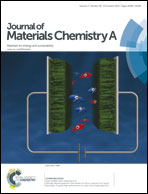Bioprocess-inspired synthesis of hierarchically porous nitrogen-doped TiO2 with high visible-light photocatalytic activity
Abstract
Inspired by the structure-forming process of biominerals, scientists have been successful in synthesizing materials with elegant structures by using organic matrices as templates. However, there are still issues relating to the exquisiteness and complexity of natural organic matrices in living organisms which have kept their activities out of chemists' control, in particular the functional properties of such materials. Here we employ natural assorted proteins, which are derived from the extrapallial fluid in living mussels, to synthesize hierarchically porous nitrogen-doped TiO2 in a single process. The silk-like organic residues in the powders clearly show that the proteins act to segment the space for TiO2 nucleation. We also demonstrate phase control over the material, with the ability to synthesize pure anatase. The synthesized TiO2 materials show a significant improvement in visible-light photocatalytic activity for both the degradation of organic pollutants and hydrogen production. The degradation of RhB could be almost completed in just 20 min. The visible-light photocatalytic activities vary with the concentrations of EPF proteins, and the optimal concentration of protein was found to be 600 μg mL−1. The present work highlights its potential application as a natural organic matrix in producing advanced materials with optimized functional properties.


 Please wait while we load your content...
Please wait while we load your content...